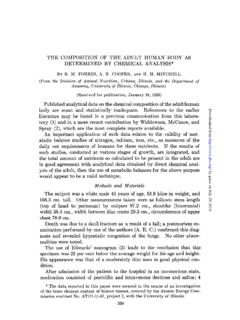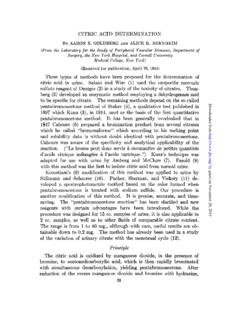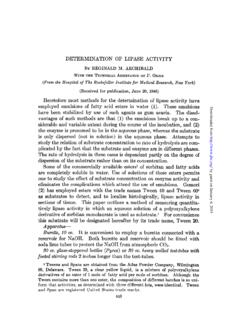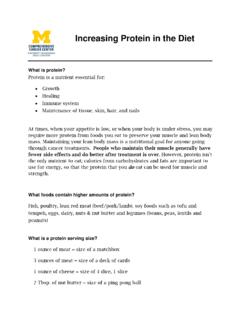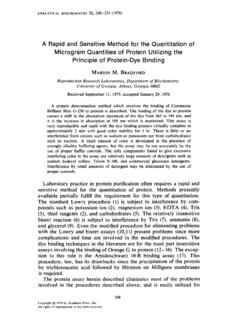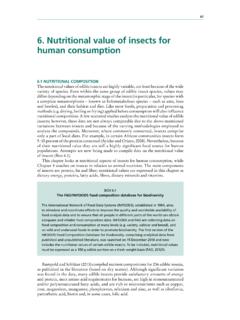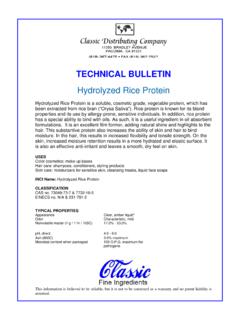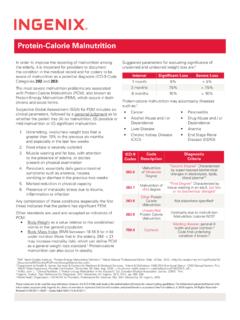Transcription of PROTEIN MEASUREMENT WITH THE FOLIN PHENOL REAGENT*
1 PROTEIN MEASUREMENT WITH THE FOLIN PHENOL REAGENT* BY OLIVER H. LOWRY, NIRA J. ROSEBROUGH, A. LEWIS FARR, AND ROSE J. RANDALL (From the Department of Pharmacology, Washington University School oj Medicine, St. Louis, Missouri) (Received for publication, May 28, 1951) Since 1922 when Wu proposed the use of the FOLIN PHENOL reagent for the MEASUREMENT of proteins (l), a number of modified analytical pro- cedures this reagent have been reported for the determination of proteins in serum (2-G), in antigen-antibody precipitates (7-9), and in insulin (10). Although the reagent would seem to be recommended by its great sen- sitivity and the simplicity of procedure possible with its use, it has not found great favor for general biochemical purposes. In the belief that this reagent, nevertheless, has considerable merit for certain application, but that its peculiarities and limitations need to be understood for its fullest exploitation, it has been studied with regard effects of variations in pH, time of reaction, and concentration of react- ants, permissible levels of reagents commonly used in handling proteins, and interfering Procedures are described for measuring pro- tein in solution or after precipitation wit,h acids or other agents, and for the determination of as little as y of PROTEIN .
2 Method Reagents-Reagent A, 2 per cent N&OX in N NaOH. Reagent B, per cent in 1 per cent sodium or potassium tartrabe. Reagent C, alkaline copper solution. Mix 50 ml. of Reagent A with 1 ml. of Reagent B. Discard after 1 day. Reagent D, carbonate-copper solution, is the same as Reagent C except for omission of NaOH. Re- agent E, diluted FOLIN reagent. Titrate FOLIN -Ciocalteu PHENOL reagent ((II), Eimer and Amend, Fisher Scientific Company, New York) with NaOH a phenolphthalein end-point. On the basis of this titration dilute the FOLIN reagent (about 2-fold) to make it 1 N in acid. Working standards may be prepared from human serum diluted IOO- to lOOO-fold (approximately 700 to 70 y per ml.). These in turn may be checked against a standard solution of crystalline bovine albumin (Armour and * Supported in part by a grant from the American Cancer Society on the recom- mendation of the Committee on Growth of the National Research Council.)
3 265 by guest on December 16, 2020 from 266 PROTEIN MEASUREMENT WITH FOLIN REAGENT Company, Chicago); 1 y is the equivalent of y of serum PROTEIN (see below). Dilute solutions of bovine albumin have not proved satisfactory for working standards because of a marked tendency to undergo surface denaturation. Procedure for Proteins in Solution or Readily Soluble in Dilute Alkali- (Directions are given for a final volume of to ml., but any multiple or fraction of the volumes given may be employed as desired .) To a sample of 5 to 100 y of PROTEIN in ml. or less in a 3 to 10 ml. test-tube, 1 ml. of Reagent C is added. Mix well and allow to stand for 10 minutes or longer at room temperature. ml. of Reagent E is added very rapidly and mixed within a second or t,wo (see below). After 30 minutes or longer, the sample is read in a calorimeter or spectrophotome- ter. For the range 5 to 25 y of PROTEIN per ml.
4 Of final volume, it is desirable to make readings at or near X = 750 rnp, the absorption peak. For stronger solutions, the readings may be kept in a workable range by reading near X = 500 m/l (Fig. 2). Calculate from a standard curve, and, if necessary, make appropriate correction for differences between the color value of the working standard and the particular proteins being measured (see below). It is unnecessary to bring all the samples and standards to the same volume before the addition of the alkaline copper reagent, provided cor- rections are made for small differences in final volume. The critical vol- umes are those of the alkaline copper and FOLIN reagents. If the PROTEIN is present in an already very dilute solution (less than 25 y per ml.), ml. may be mixed with ml. of an exactly double strength Reagent C and otherwise treated as above. Insoluble Proteins, PROTEIN precipitates, tungstate pre- cipitates, will dissolve readily in the alkaline copper reagent.
5 However, after proteins have been precipitated with trichloroacetic or perchloric acid, for example, they will dissolve rather poorly in the N alkali of this reagent. They become even harder to dissolve if subsequently ex- with fat solvents, and still more so if dried at 100 . It is not possible to cover all cases, but the following may be helpful in measuring the PROTEIN of acid precipitates. If the amount of PROTEIN is not great, so that it is spread rather thinly, it will usually dissolve in 3 hour or so in 1 N NaOH at room temperature. Therefore, one may add, for example, ml. of 1 N NaOH to 5 to 100 y of precipitated PROTEIN . 1 For example, with the Klett calorimeter, transfer 25 to 500 y of PROTEIN in not over 1 ml. volume to a calorimeter tube. Add water if necessary to make 1 ml. Add 5 ml. of Reagent C, and, after 10 minutes, ml. of Reagent E. Readings are taken after 30 minutes with the No. 66 filter.
6 If the readings are too high, substi- tute the No. 54 filter for sample, standards, and blanks. by guest on December 16, 2020 from LOWRY, ROSEBROUGH, FARR, AND RANDALL 267 After + hour or more, 1 ml. of Reagent D (no NaOH) is added, followed after 10 minutes by ml. of diluted FOLIN Reagent E as usual. With larger samples, or very stubborn precipitates, it may be necessary to heat for 10 minutes or more at 100 in 1 N alkali. Although this may lower the readings, they will be reproducible and can be measured with similarly treated Microanalysis-With a Beckman spectrophotometer adapted to ml. volume (12), as little as y of PROTEIN may be measured with reason- able precision. Aside from reducing the volumes of sample and reagents, the only necessary change is to use sufficiently slender tubes for the re- action. If the tubes are too large in diameter, low values will result. The following is illustrative of a procedure in which it is desired to pre- cipitate the PROTEIN in order, for example, to measure an acid-soluble con- stituent of the same specimen.
7 In this example, it is assumed that the sample volume is negligible. Otherwise a smaller volume of more con- centrated trichloroacetic acid would be used. To the sample containing to 3 y of PROTEIN in a tube of 3 mm. inner diameter and 4 cm. long,s are added 10 ~1. of 5 per cent trichloroacetic After being mixed and centrifuged, 8 ~1. of the supernatant fluid are removed. To the precipitate are added 5 p-11. of 8 N NaOH. The sample is thoroughly mixed by tapping or buzzing, s and is covered e Bovine serum albumin is especially difficult to redissolve after precipitation. Several 40 mg. samples were precipitated with trichloroacetic acid, washed with alcohol and isopropyl ether, and dried. These samples dissolved very slowly in 2 ml. of 1 N NaOH. However, after standing overnight, the PROTEIN appeared to be nearly all dissolved and aliquots gave readings 97 per cent of those obtained with non-precipitated samples.
8 Other samples were heated for 30 minutes at 100 in 1 N NaOH. These samples dissolved and the solution turned slightly yellow. The final readings checked well but were only 82 per cent of those obtained with non- precipitated samples. Possibly, heating at lower temperature with the 1 N NaOH would have sufficed, although heating with weaker alkali would not have been effec- tive, judging from other experience. The use of stronger alkali than 1 N did not appear to be an improvement. 8 These tubes are cleaned by rinsing with dilute NaOH, boiling in half concen- trated HNOa, and rinsing several times in redistilled water. Filling or emptying of a beaker full of tubes (tall form of beaker without lip) is accomplished by slow centrifugation for a few seconds. For emptying, the tubes are transferred upside down to a second beaker with a false bottom of stainless steel screen. With the slow centrifugation required beakers will not be broken.
9 4 Suitable micro pipettes are the Lang-Levy variety (13, 14). For entering these narrow tubes the bent tip must be especially short and slender. 5 The tube is held at an angle against a rapidly rotating flattened rod or nail. Any high speed hand tool mounted in a clamp is satisfactory. The contents of the tube will mix violently without spilling (15). A similar effect may be had with a commercial rubber-tipped massage vibrator. by guest on December 16, 2020 from 268 PROTEIN MEASUREMENT WITH FOLIK REAGEST with a rubber cap or Parafilm. After 30 minutes, 50 ~1. of Reagent D are added and the sample is mixed by buzzing. After 10 minutes or more, 5 ~1. of diluted FOLIN Reagent E are added with immediate buz- zing, and the samples are read after 30 minutes. Standards are perhaps best prepared by precipitating 5 ~1. of 5, 10, 20, etc., mg. per cent solu- tions of serum PROTEIN with 5 ~1. of 10 per cent trichloroacetic acid, with subsequent treatment as for the other samples.
10 EXPERIMENTAL There are two distinct steps which lead to the final color with PROTEIN : (a) reaction with copper in alkali, and (b) reduction of the phos- phomolybdic-phosphotungstic reagent by the copper-treated PROTEIN . Reaction. wifh Copper in Alkaline Solution-The salient features of this follow. (1) The color obtained in the absence of copper is prob- ably attributable entirely to the tyrosine and tryptophan content (16, 17), and this is not greatly increased by alkaline pretreatment ((4-6) and Table I). (2) In the presence of copper, alkaline treatment of proteins results in a 3- to 15-fold increase in color, but, in contrast, the presence of copper has only a small effect on the color obtained with free tyrosine and tryp- tophan (Herriott (17, 18) and Table I). (3) The reaction with copper, although not instantaneous, is nearly complete in 5 or 10 minutes at room temperature under the prescribed conditions. Heating to 100 or increas- ing the concentration of alkali accelerates the reaction with copper without changing the final color.


